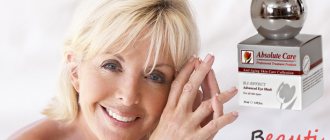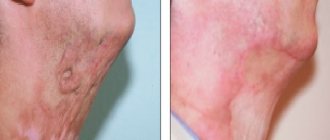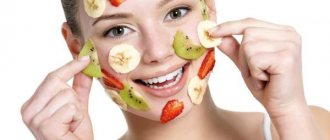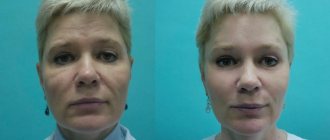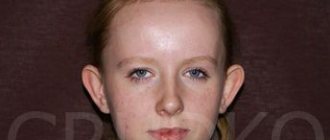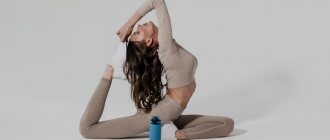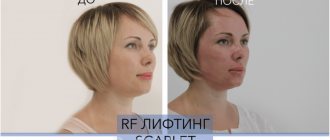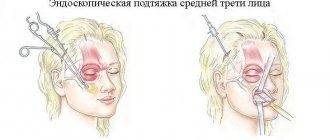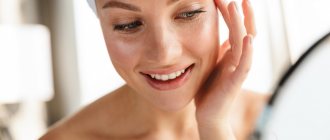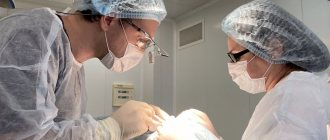Effect after Fraxel
With the help of Fraxel, it is possible to achieve skin rejuvenation even after a single session. Thanks to photothermolysis, the relief of the skin is smoothed, the tone becomes more even, focal hyperpigmentation is eliminated, small wrinkles, scars, the effects of burns or acne are removed, tone and elasticity are normalized, and pores are narrowed.
Subjective sensations
The entire rehabilitation period is about 2 weeks. The first positive results can be noted within the first week after Fraxel, but for some time you will have to be patient. Certain subjective sensations may be unpleasant. For the first few days, it is better not to go to work and try to avoid contact with strangers.
Swelling is possible, but lasts only 1-2 days. Peeling and redness of the skin may last longer and even cause some inconvenience. The intensity and duration of such manifestations depends on the degree of exposure to the patient’s skin, the depth of laser penetration and the individual characteristics of the body.
Peeling and redness are caused by the restoration of the surface layer of the epidermis. As a result of Fraxel treatment, dead and damaged cells are removed and intensively replaced with new ones. Peeling is the rejection of the layers of skin being removed. Redness (hyperemia) indicates an intensive process of restoration and formation of new cells. The entire process of replacing the old epidermis with a new one takes about a week, but the intensity of peeling decreases after 3-4 days.
Many patients complain of a burning sensation, the face “burns” as if from a sun or heat burn. This is also normal and should not cause much concern. The burning sensation indicates that the recovery process is taking place intensively.
In the last 10-15 years, chemical peels have become widespread in cosmetology and aesthetic medicine, and are now included in most facial skin care programs. The result of chemical peeling is the stimulation of regeneration processes, considered as a “skin rejuvenation effect.” In this regard, this procedure is popular and in demand. To date, more than 50 commercial names of chemical peels have been registered, in which dozens of substances are used as active agents. At the same time, any chemical peeling causes damage and necrosis of epidermal or dermal cells, as a result of which the barrier properties of the skin are reduced and microcirculation is disrupted. In the absence of rehabilitation after chemical peeling, the skin’s ability to self-heal is reduced [1, 2].
In the process of physiological cleansing of the skin from damaged tissues, neutrophils and macrophages migrate, fibroblasts synthesizing collagen are activated, and with the participation of keratinocytes, the epidermis is restored, resulting in the restoration of the protective properties of the skin. In skin regeneration after chemical peels, the most important is the functional state of the basal layer of the epidermis, the cells of which have mitotic activity due to the large number of RNA and DNA containing structures. The cosmetic effect of chemical peeling depends on the depth of damage to the epidermis, which determines the intensity and nature of changes in the structure of the skin, their stability and possible adverse reactions or complications (dehydration, erythema, swelling, peeling). Most of the complications that develop as a result of the intervention (chemical peeling) are nonspecific and are formed as a result of direct damage to the integrity of the skin or the development of an inflammatory reaction. That is why early rehabilitation, which is carried out until the skin is completely restored, is designed to eliminate disorders caused by peeling and reduce the number of possible complications [3, 4].
During post-peeling care, it is necessary to ensure skin hydration, since active hydration of the epidermis ensures normal epithelization and reduces the risk of scarring. In addition, antioxidants must be included in the post-peeling care program to reduce the severity of the inflammatory reaction and the risk of developing hyperpigmentation. An important part of skin care should be the prevention of bacterial infection to prevent unwanted skin infections [5].
When carrying out chemical peels, it is necessary to take into account that due to the influence of the chemical factor, inflammatory processes in the skin intensify. This reaction is expected and is aimed at restoring or replacing damaged tissue. To eliminate persistent manifestations of inflammation, such as severe erythema or persistent edema, special therapy is necessary [1].
The products that are currently used for post-peeling care (gels, serums, creams, emulsions) have a significant impact on the final result of peeling and minimize its possible undesirable consequences. This approach provides the opportunity to introduce new products into cosmetology practice to increase the effectiveness of peelings, consolidate their results and reduce the risk of complications. the Aisida cosmetology series are promising for use in post-peeling care.
, which is justified by the good results of using their components for the treatment of chronic dermatological diseases - atopic dermatitis, eczema, psoriasis.
Material and methods
The study included 30 patients who underwent one of the chemical peels in accordance with the recommendations of the manufacturers: coral Ros de Mer (10 people; Christina, Israel); retinoic Block-Age (10 people; “Mediccontrolpeel”, Brazil), methodological recommendations for conducting chemical peels were used; glycolic MMS 30-70% (10 people; Dermatologic Skin Care Lab, USA), methodological recommendations were used.
On the 2nd day after peeling, all patients were prescribed skin care products from the Aisida
: cleansing milk (applied to remove impurities from the epidermis) and cream-gel for dry and sensitive skin (applied to the skin of the face in the first 3 days - 2 times a day, later when peeling increases - 3 times a day).
The local skin status of patients was assessed on days 1–8 after peeling. For this purpose, we used a developed proprietary method based on a scoring gradation of the severity of changes in the skin (erythema, swelling, peeling; Table 1).
To assess local status, the average score was calculated.
For statistical analysis, the nonparametric Mann–Whitney U test was used. Differences were considered significant at p<0.05.
Results and discussion
1 day after peeling, pronounced signs of skin irritation were observed. At the same time, the most significant skin changes were observed in patients after coral and retinoic peels (groups 1 and 2, respectively) both in terms of the severity of individual symptoms (erythema, swelling) and in terms of the total score. During the same observation period, facial skin after retinoic peeling was characterized by severe peeling. Less pronounced changes were noted after glycolic peeling (Table 2).
Application of cosmetic products from the Aisida
had a beneficial effect on the condition of facial skin in the post-peeling period.
The results of assessing skin manifestations suggested good effectiveness of cleansing milk and cream-gel for dry and sensitive skin. During the dynamic observation, features were identified both in the duration of the manifestation of symptoms of inflammation and skin regeneration, and in the degree of their severity, depending on the peeling option performed. Thus, after coral, retinoic and glycolic peeling, a complete absence of skin symptoms was noted on days 6-8; erythema and swelling, reflecting the inflammatory process in the skin, disappeared on days 4-6. On the 4th day of observation (3rd day of using Aisida
) in women after retinoic peeling (group 2), the severity of erythema and swelling on the facial skin decreased with signs of moderate peeling;
after coral peeling, pronounced peeling was observed with a significant decrease in erythema and swelling; Patients after glycolic peeling experienced only moderate peeling. On the 5th day after peeling (4th day of using Aisida
), peeling of the skin remained in patients of the 1st and 3rd groups, pasty skin against the background of moderate peeling and mild erythema in patients of the 2nd group (Table 2).
Positive effect of post-peeling facial skin care using Aisida
due to the activity of their components.
These products contain an antiseptic Dorogov stimulant (ASD), enclosed in liposomes for deeper penetration of the products into all layers of the skin. ASD is a unique complex of biologically active substances that affect almost all body systems. It is an animal product obtained by pyrolysis. The original method of dry sublimation allows you to break down organic substances (proteins, fats, carbohydrates) into low molecular weight components, which in their structure are the building material of cells. ASD is a powerful adaptogen that increases the body’s resistance to harmful environmental factors. In addition to the ASD complex, the components of Isis
are coenzyme Q10, burdock root extract, as well as oils (schisandra chinensis, cocoa, olive, linden flowers, lavender). Coenzyme Q10 exhibits antioxidant activity, stimulates the renewal of skin cells, the production of collagen, which helps protect the skin from loss of hyaluronic acid (moisture preserver), restore elasticity, youth and beauty of the skin [4].
Burdock root extract has a tonic, bactericidal, antiallergic effect. Schisandra chinensis oil eliminates itching, burning, swelling, and increases the efficiency of metabolic processes in the body. Cocoa butter nourishes, moisturizes, softens, revitalizes and tones the skin, making it even more tender, smooth and radiant, and has smoothing properties. Olive oil is rich in vitamins and microelements, has a disinfectant and wound-healing effect, and is therefore used for inflamed and dehydrated skin. Linden flower oil extract prevents peeling, has a moisturizing, anti-inflammatory and protective effect, and helps eliminate swelling. Lavender oil has anti-inflammatory, antiseptic and analgesic properties, promotes rapid healing and prevents scarring.
Complex action of Isis
prevents unwanted skin infections by increasing local immunity and activating metabolic processes.
The identified difference between the effect of the Aisida
in different groups of patients may be due to the peculiarities of the chemical composition of the components used for peelings and, consequently, the depth of impact. Thus, it is believed that coral and retinoic peels are classified as medium peels, while glycolic peels are considered to be superficial peels. This was confirmed by the highest number of points when assessing the local status of the skin of patients one day after coral and, especially, retinoic peeling.
Thus, post-peeling application of the Aisida
provides complete post-peeling facial skin care (reduces the severity of the inflammatory reaction of the skin, ensuring its regeneration).
The effectiveness of the products used depends on the type of peeling used, which should be taken into account when predicting the duration of the post-peeling period and the dynamics of manifestations of the local status. Products from the Aisida
, in particular cleansing milk and cream-gel for dry and sensitive skin, are advisable to use in cosmetology during the post-peeling period.
Rehabilitation rules
If you follow the doctor’s recommendations, rehabilitation will not cause major problems, and the effect after Fraxel will be more pronounced.
Patients must adhere to the following rules:
- Avoid exposure to direct sunlight and artificial ultraviolet radiation. At this time, it is better to be outdoors less often, and if you do have to go outside, you need to wear a wide-brimmed hat and sunglasses. Solarium is contraindicated.
- To reduce burning and peeling, you can use mild moisturizing creams and masks. Any peeling of peeling areas is contraindicated. Panthenol has a good restorative effect.
The response to Fraxel and the duration of rehabilitation are individual for each person. The maximum positive effect after the procedure depends not only on the skill and experience of the doctor, but also on how carefully the patient follows his recommendations. In our cosmetology clinic you can use the skin rejuvenation service using laser fractional photothermolysis and undergo a full course of rehabilitation under the supervision of specialists.

